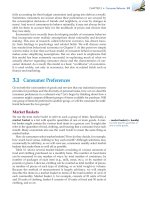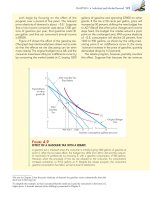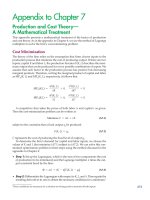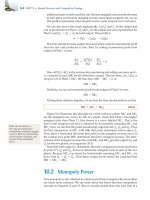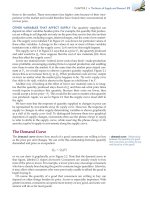(8th edition) (the pearson series in economics) robert pindyck, daniel rubinfeld microecon 277
Bạn đang xem bản rút gọn của tài liệu. Xem và tải ngay bản đầy đủ của tài liệu tại đây (74.8 KB, 1 trang )
252 PART 2 • Producers, Consumers, and Competitive Markets
Capital
C1
F IGURE 7.7a
ENERGY EFFICIENCY THROUGH
CAPITAL SUBSTITUTION FOR LABOR
Greater energy efficiency can be achieved if
capital is substituted for energy. This is shown
as a movement along isoquant q1 from point
A to point B, with capital increasing from K1
to K2 and energy decreasing from E2 to E1 in
response to a shift in the isocost curve from
C0 to C1.
B
K2
A
K1
q1
E1
E2
Energy
(a)
F IGURE 7.7b
Capital
ENERGY EFFICIENCY THROUGH
TECHNOLOGICAL CHANGE
Technological change implies that the
same output can be produced with smaller
amounts of inputs. Here the isoquant labeled
q1 shows combinations of energy and capital that will yield output q1; the tangency
with the isocost line at point C occurs with
energy and capital combinations E2 and K2.
Because of technological change the isoquant shifts inward, so the same output q1
can now be produced with less energy and
capital, in this case at point D, with energy
and capital combination E1 and K1.
C
K2
D
K1
q1
New q1
E1
E2
Energy
(b)
C0

